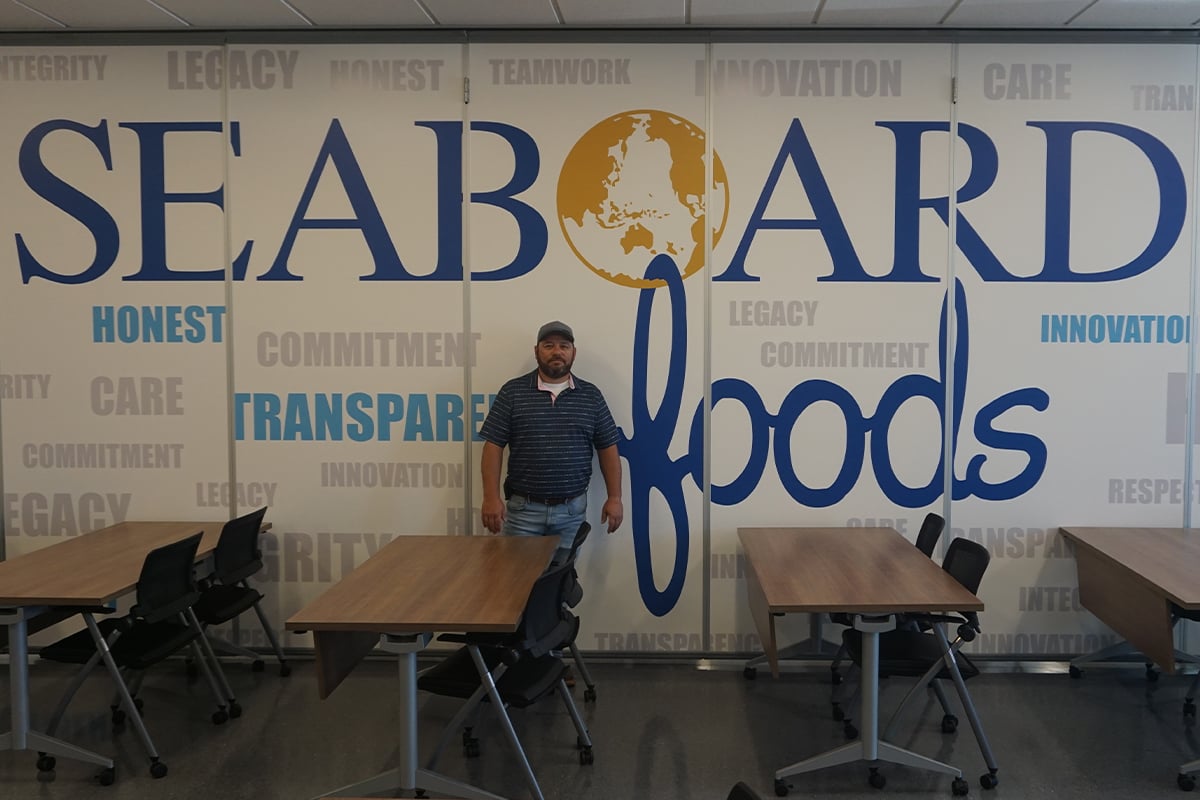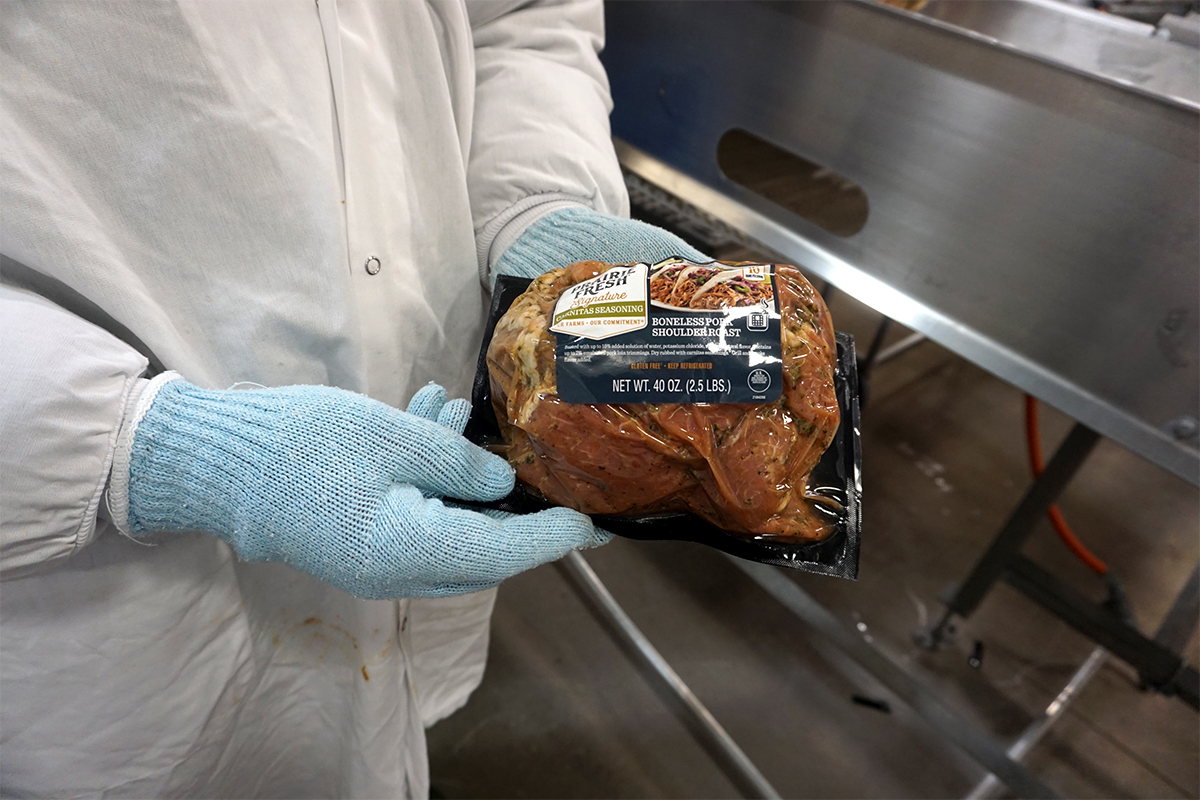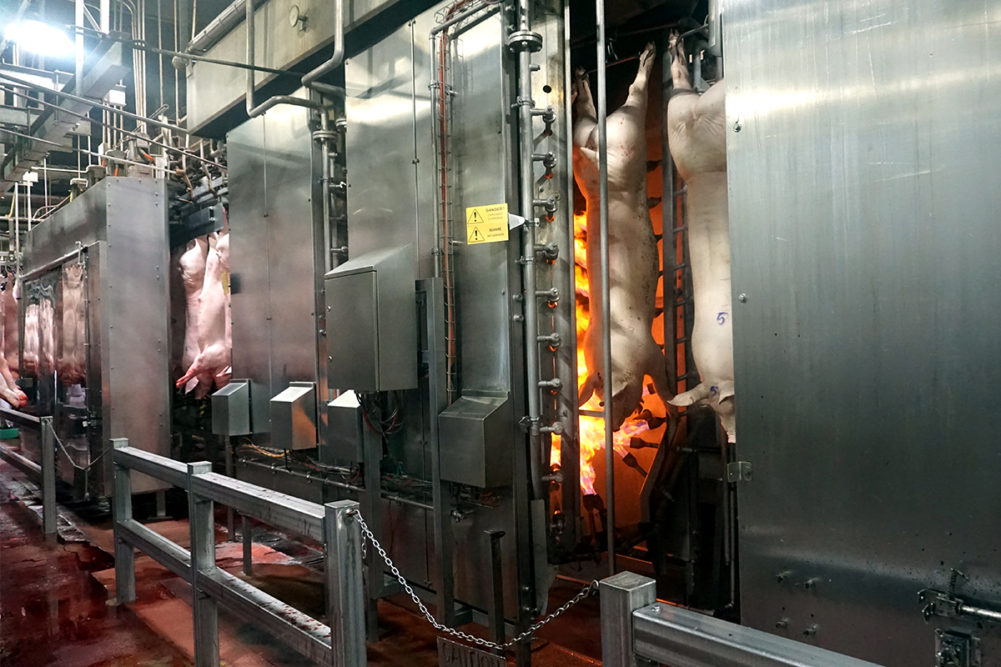Seaboard Foods’ Guymon, Okla., processing plant has received two significant additions in the last two years. The first occurred roughly a year ago and included six new cube cooler bays that cover approximately 100,000 square feet, a new 40,000-square-foot freezer and a new snap chill system. The company tore out the old cooler bays and installed the new snap chill in that space and converted the old snap chill into part of head boning and additional combo storage.
“It was about 180,000 square feet and the company spent a little over $100 million on those upgrades,” said Rick Sappington, vice president and general manager of the Guymon facility.
The latest addition, in the midst of the final finishing touches, covers 30,000 square feet and includes a new human resources (HR) wing with new offices, two conference rooms, a reception area, and visitor and interview rooms. But the new addition primarily serves the Guymon plant’s employees and their well-being and comfort.
COVID provided the impetus for the Seaboard plant to find and learn new best practices in all aspects, but employee welfare remained at the top. The HR department became extremely efficient and resourceful, and that led to an occupational health clinic and more.
“The rest of the world saw it as negative, but I chose to view it as an opportunity to improve,” said Jennie Watkins, who has served as the facility’s HR director for five years.
The new clinic, which includes a nurse care manager, offers treatment for routine ailments, flu shots, mammograms, vision services and an onsite mobile service for diabetics. New training rooms for more than 135 people provide orientation every two weeks with training materials in both English and Spanish. The addition also includes a new cafeteria, coffee break areas, and locker rooms.
“The whole addition is meant to improve employee welfare areas,” Watkins said.
 Vice President and General Manager Rick Sappington has worked his way up through multiple positions during a 22-year career at the Guymon plant. (Source: Sosland Publishing Co./Bob Sims)
Vice President and General Manager Rick Sappington has worked his way up through multiple positions during a 22-year career at the Guymon plant. (Source: Sosland Publishing Co./Bob Sims)An institution in Oklahoma
Construction of Seaboard’s original plant in Guymon began in 1993 and it started producing pork in 1996. With the two newest additions, the plant covers more than 1 million square feet. The facility processes 21,500 hogs a day, five to six days a week on two production shifts equaling 4 million lbs of ready-to-sell pork a day. A third shift handles sanitation.
“The goal is to process over 6 million head a year,” said Sappington. “That’s not capacity. That’s just our goal. Our number at full tilt would be right under 7 million in a year.”
After arrival at the plant, hogs are led to a controlled atmosphere stunning system Seaboard installed outside of the plant and then constructed a building around in 2008, a project Sappington oversaw as a superintendent managing all maintenance and electrical projects of the facility.
“We still employ a sensibility monitor,” he said. “Their job is to look at every animal that comes out of stunning to make sure they were euthanized correctly.”
Each carcass gets a 7 mm cut for full bleed before moving through a hot water scalder, then two stages of singing and polishing, and finally rinsing. It’s then scanned for marbling and given a score. It moves to processing from there.
Automation in harvesting and fabrication gives the Guymon facility the level of efficiency necessary to process its 21,500 hogs a day. As the line moves, a light beam automatically measures the distance from the floor to the nose. The robot used to drop the head uses the measurement to calculate the exact location to make the neck cut for head dropping.
An employee finishes dropping the head by hand after the first neck cut. A system is then used to sync the head to the carcass it came from. This allows for traceability of the animal throughout all facets of evisceration and inspection through processing all the way to packaging. Seaboard has peppered robots and automation throughout the rest of processing and cutting at the Guymon plant, from cutting the brisket, hams and shoulders to ribs, loins and bellies.
“Our split saws are automated, our neck bone clippers are automated, on the cut floor it’s somewhat similar automation,” Sappington said. “It’s really for the employees’ purposes there. At the loin puller area, we’re using 3D camera vision systems to make decisions about cuts for the loin, the belly, and then how they get separated. As you go further, we have an automatic rib puller for pulling the ribs.”
The facility uses a robotic aitch bone cutter and two split saws and neck bone cutters that alternate and cut every other carcass. Once carcasses reach fabrication, ribs are removed from bellies and bellies are trimmed.
The rib puller uses a 3D vision scan of the rib on the belly and uses the image to decide where to cut for removal of the rib. The machine bases its guidance on preprogrammed parameters established by the company. The belly trimmer functions in a similar way. It uses the same 3D vision within the designated parameters and determines a start weight and end weight based on those parameters. The machine will also use those parameters to generate a product code according to customer. The facility now knows the finished weight going into each combo for a specific customer and what’s going to trim.
“So, we know what the combo weight is going to the customer for each combo,” Sappington said. “And we know how much trim we produce, which we’ll send to trim blend because we blend all our trim here and we sell it to other customers.”
Automated packaging machines, some with robotic arms, package the various cuts and send them to be boxed if necessary. Each robotic bagger replaces the need for four workers. Some cuts are sent to value add to receive seasoning through either injection or tumbling and are packaged there by a pouch loader.
Seaboard uses its Prairie Fresh brand for all of its products including retail, foodservice and pieces of its international distribution (both retail and foodservice), while other international product is currently transitioning to Seaboard Foods branding. The Guymon plant also processes a lesser percentage under a private label for a major retailer, said David Eaheart, senior director of communications and brand marketing.
 Prairie Fresh branded value-added pork is seasoned using injection or tumbling technology before being packaged for sale at retail. (Source: Sosland Publishing Co./Bob Sims)
Prairie Fresh branded value-added pork is seasoned using injection or tumbling technology before being packaged for sale at retail. (Source: Sosland Publishing Co./Bob Sims)Supply integration
Including feed, pigs for processing and sows, trucking, etc., Seaboard Foods’ processing facility in Guymon, Okla., is “the most integrated pork plant you’ll find in the country,” Eaheart said.
Seaboard does have a mix of company owned and contracted production farms but owns a majority of its sow farm operations. Each farm averages roughly 3,500 sows, some are bigger, and some are smaller, as well as four to six boars. Seaboard Foods operates farms in Western and Central Oklahoma, Northern Texas, Western Kansas, Eastern Colorado and Iowa.
“We operate 92 sow farms that house 330,247 sows,” said Noel Williams, senior vice president of live operations and 30-year veteran of the pig production industry.
Seaboard starts with genetics from Hendersonville, Tenn.-based Pig Improvement Company (PIC) based on maternability and reproductive traits such as number born, live births, ability to milk, leg structure, etc. The sows are large white landrace, and the sires are durocs. The landrace offers strong maternability and the duroc provide meat quality.
“The Seaboard Guymon plant starts on the farm,” Williams said.
The sow farms work on a 1,000-day calendar unique to pig production based around a sow’s gestation period. Gilts (new sows that have not been bred yet) start at around 300 lbs and go through six to seven farrowing cycles with gestation periods lasting approximately 115 days. The process lasts roughly 2½ years and sows grow to 450-500 lbs over that time.
“After six litters, we watch the sows for a decline in production,” said Alex Weatherford, production manager at Farm #39 in Texas County, Okla. “If they’re still healthy they go through another cycle, if not they are culled.”
Seaboard sells the culled sows to processors for sausage products.
The average gestation period for sows is 115 days give or take one and a half days. Litters average 15 live born piglets. The newborn pigs grow from 1½ lbs at birth to 15 lbs in about 25 days and are then moved to the finishing barn. At four to five days old, piglets receive shots, get their tails bobbed to prevent biting and are castrated to eliminate hormones from tainting the taste of the meat.
Four to seven days past weening of the litter, farrowing sows are checked for heat to begin the process again. Sows receive two artificial inseminations for breeding — boars are used to check heat only — unless they are not in heat when checked. The farm continually cycles boars through the heat check procedure to ensure they remain “active” through the process.
Serving people
The Seaboard plant takes its status as the largest employer in Guymon very seriously. Including the farms in the Texas County region, Seaboard Foods employs nearly 4,000 of its 5,500 total employees in the Guymon area and the plant stresses employee safety.
Upon hire, Seaboard employees go through orientation and receive a safety booklet to prepare them for performing their jobs safely. Then, throughout the year the plant does monthly safety rollouts.
“So having the training center for us to be able to do that is imperative,” Sappington said of the new training room.
Seaboard Guymon also distributes monthly safety bulletins covering selected topics for its employees. Topics range from things that might have happened at the Guymon plant to things that haven’t, but might happen at the Guymon plant, to things that happened elsewhere in the Seaboard system across all the company’s facilities.
“Whether it’s at the mill, the farms or one of our other plants, we share the information because they are so similar to each other,” Sappington said. “There might not have been an incident that happened here, but we start notifying employees about a potential risk. And then the safety team comes in and we start evaluating if that risk is actually here or not.”
Keeping employees safe plays an integral role at an operation the size of the Guymon plant, and that includes all the workers outside of the plant that contribute to its success, and every person in the system counts as a key employee.
“I mean every employee down our process, all the way down to the shipping dock,” Sappington said.
That attitude carries over to Seaboard’s affinity to developing talent and promoting internally, which is the case with Sappington, who started his career at the Guymon plant in 2001 as an electrician and is now the vice president and general manager of the facility.
There are many employees who have worked at the Guymon plant longer than Sappington (22 years). At the plant’s 25th anniversary Seaboard recognized over 100 employees that had been at the Guymon facility for the entire 25 years. One family, Sappington noted, has five generations at the plant. All five generations still work at the plant today. But its employees aren’t the only people Seaboard serves.
The company makes a point of serving the communities it operates in, and the Guymon/Texas County region is the largest with more than 4,000 of Seaboard Foods’ 5,500 total workforce across the five states it operates in. The Seaboard Foundation built a soccer complex in Guymon. To ensure employees don’t use paid days off on parent-teacher conferences, the Guymon plant works with the schools to bring teachers to the plant to meet with parents who work there.
“We try to set up open enrollment for their kids the following year,” Sappington said. “We always invite the school to come out. They’ll usually bring a few people, and we help assist with it so parents can get their kids enrolled for next year or have their teacher meetings here. It’s a benefit to our employees, but it’s also a benefit to the school.”
In October 2023, Seaboard put on the 4B Festival in downtown Guymon featuring bacon, barbecue, brews and blues as a community appreciation event. The company fed the people of Guymon and offered games and an overall family atmosphere as a thank you to the entire community.
“But it’s not just Guymon,” Eaheart said. “We’re still focused on community relations even in the small towns where we have farm operations.”
“We have to be,” Sappington added. “As spread out as we are, we have to be good community stewards everywhere we’re at. We have land acquisitions all over, we have farms all over, we’re spread out everywhere. So, we have to be good neighbors.”



